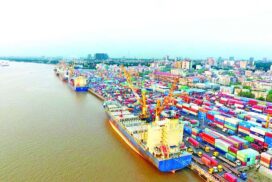Myanmar’s trade gap has significantly narrowed to US$168.202 million in the first half of the current financial year 2020-2021 from just $1.29 billion registered in the corresponding period of the 2019-2020FY, according to data provided by the Ministry of Commerce.
The drastic drop in imports is a contributing factor to a decrease in trade deficit this year.
Between 1 October and 2 April in the current FY, Myanmar’s external trade drastically plunged to $15.78 billion from $20.36 billion recorded in the year-ago period.
While exports were estimated at $7.8 billion, imports were valued at $7.9 billion this FY. Compared to the FY2019-2020, exports showed a drop of over $1.7 billion, while imports fell by $2.85 billion.
Myanmar witnessed a slump in exports and imports triggered by the coronavirus pandemic.
Both sea trade and border trade dropped amid the coronavirus impacts and political changes.
The neighbouring countries tightened the border security and limited trading time to contain the virus’s spread. For maritime trade, disruption in the logistic sector, some ocean liners’ suspension, and the pandemic-induced container shortage somehow scaled down the maritime trade.
“The lack of money in circulation due to the closure of private banks decreases economic efficiency,” an exporter stressed.
Political uncertainties, reduced mobility derail the main contributors to the economy, and certain restrictions on banking, businesses’ operations, logistics, and network services, World Bank stated.
Myanmar exports agricultural products, animal products, minerals, forest products, and finished industrial goods.
At the same time, it imports capital goods, raw industrial materials, and consumer goods.
The country’s export sector relies more on the agricultural and manufacturing sectors. The Ministry of Commerce is endeavouring to boost export under World Trade Organization’s rules, enhance value-added production and competitiveness, reduce export barriers and provide trade financing services.
The government is trying to reduce the trade deficit by screening luxury import items and boosting exports. The country mainly imports essential goods, construction materials, capital goods, hygienic material and supporting products for export promotion and import substitution.
Myanmar’s trade deficit was pegged at $1.3 billion in the 2019-2020FY, $1.14 billion in the 2018-2019 FY, $1.3 billion in the previous mini-budget period (April-September, 2018), $3.9 billion in the 2017-2018FY, $5.3 billion in the 2016-2017FY, and $5.4 billion in the 2015-2016FY, according to statistics released by the Central Statistical Organization.
Under the National Planning Law for the Financial Year 2020-2021, Myanmar intends to reach the export target of US$16 billion and import at $18 billion.
The Ministry of Commerce has adhered to its policy reform depending on the State and people’s requirements.
Moreover, a series of trade liberalization and openness for policy development have been introduced for enhancing a more viable trade environment.
The private sector plays a prominent role in Myanmar’s market-oriented economic system. The ministry is highlighting free and fair trade, ensuring product safety and quality goods and services. — MM/GNLM
Trade deficit sharply narrows in H1 on falling imports
- April 15, 2021
- 715













